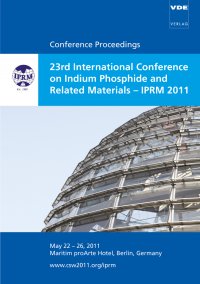Analysis and optimization by micro-beam X-ray diffraction of Al-GaInAs heterostructures obtained by Selective Area Growth for optoelectronic applications
Konferenz: IPRM 2011 - 23th International Conference on Indium Phosphide and Related Materials
22.05.2011 - 26.05.2011 in Berlin, Germany
Tagungsband: IPRM 2011
Seiten: 4Sprache: EnglischTyp: PDF
Persönliche VDE-Mitglieder erhalten auf diesen Artikel 10% Rabatt
Autoren:
Guillamet, Ronan (FOTON INSA, 20 av. des buttes de Coësmes, 35000 Rennes, France)
Lagay, Nadine; Decobert, Jean (III-VLab, Route de Nozay, 91460 Marcoussis, France)
Mocuta, Cristian (SOLEIL, L'orme des Merisiers, 91190 Saint Aubin, France)
Carbone, Gerardina (ESRF, 6 Rue Jules Horowitz, 38000 Grenoble, France)
Lagrée, Pierre-Yves (IJLRA, Université Paris 6, 4 Place Jussieu, 75005 Paris, France)
Inhalt:
Growth of AlGaInAs/InP heterostructures by Selective Area Metal Organic Vapour Phase Epitaxy is investigated in this paper using advanced characterization techniques and numerical modelling. Synchrotron radiation and X-Ray optics allow to have micro or sub-micro X-Ray probe. With this probe, it is possible to characterize our samples by X-Ray Diffraction on very restricted area. This technique was first used on adapted samples to measure locally thickness and composition vatriation and thus to deduce the diffusion length D/ks of the different elements from group III in the vapour phase. The difficulty was to precisely quantify the D/ks simultaneously three elements from group III. In particular Aluminium D/ks parameter was extracted for the first time by X-ray microprobe techniques. D/ks is the only adjustable parameter of the vapour phase diffusion model. This model predicts thickness, composition and emission wavelength everywhere on the substrate and is used to design the dielectric mask patterning. D/ks is consequently a critical parameter and must be known precisely. Strain compensated AlGaInAs MQW were investigated and completely mapped by X-Ray diffraction in order to quantify material thickness and composition. Measurement and simulation have been compared and have shown excellent agreement. This comparison validates the numerical model and then will be used to design next generation of integrated devices.


